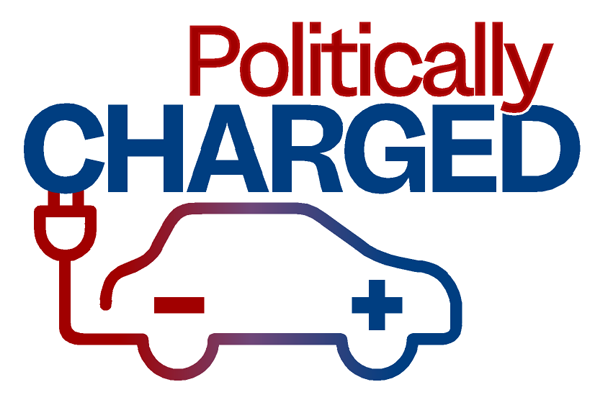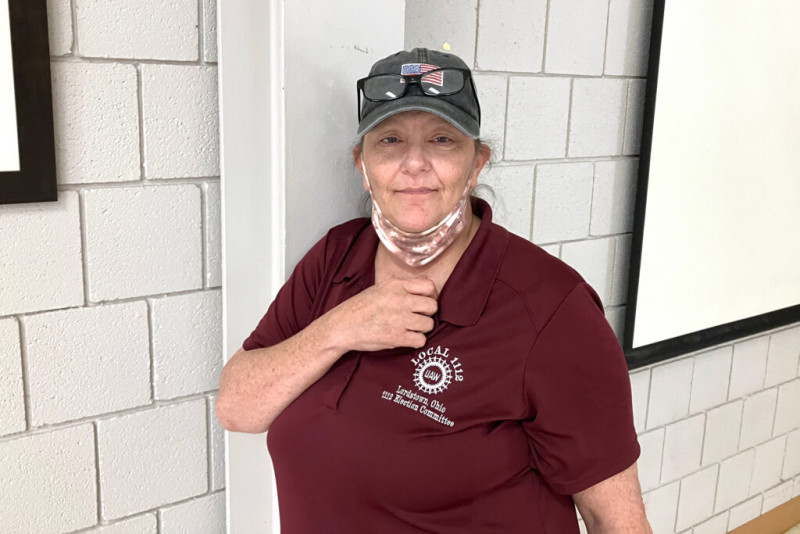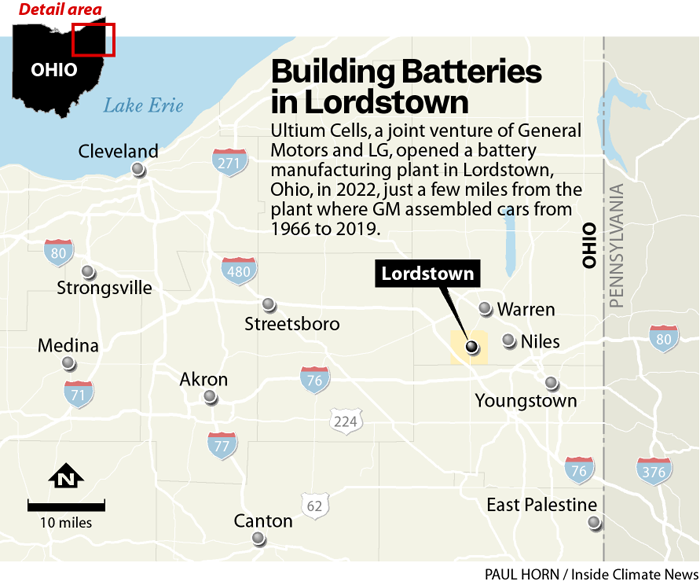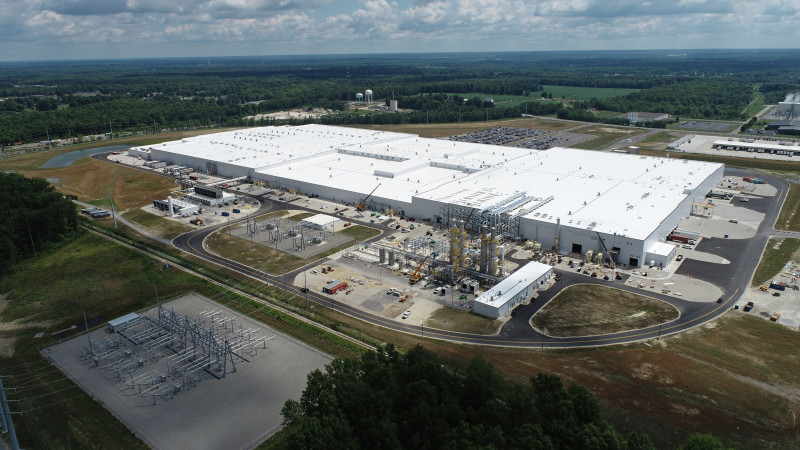Unionized Workers Making EV Batteries Downplay Politics of the Product
Politically Charged: Fifth in a series about how political polarization threatens the EV future.
LORDSTOWN, Ohio—Not long ago, the shift to electric vehicles looked like it would be bad for workers.
The scenario went like this: Factories that make gasoline engines and transmissions, many of which are represented by unions, would shrink and eventually consolidate or close, while new jobs manufacturing EV batteries would be done at new, non-union plants.
But events in 2023 helped to rewrite the story.
The United Auto Workers, under the leadership of a new president, Shawn Fain, took an aggressive stance in contract negotiations with Ford, General Motors and Stellantis. The union went on a partial strike beginning in September and won concessions that included welcoming the union into battery plants the auto companies were building as joint ventures with battery companies.
Explore the latest news about what’s at stake for the climate during this election season.
At that time, just one joint venture plant had opened: Ultium Cells in northeast Ohio, co-owned by GM and LG. What has happened at that plant since then gives hope that the transition to EVs can be a net positive for workers.
“It’s the future,” Lisa Moore, a worker at the plant, said about EVs. “And there is no stopping us.”
Because of the union contract that was finalized in June, she earns nearly $30 per hour, almost double her $16.50 starting pay when the plant opened two years ago. The contract covers about 1,750 employees, the large majority of people at the plant.
This spring, Ultium began production at its second plant, in Spring Hill, Tennessee. On Sept. 4, the UAW said a majority of workers at the plant had signed cards and Ultium agreed to recognize the union. But the Ultium sites are the exception—Tesla and other EV battery manufacturers have resisted unions.

Workers and industry analysts want to know how the shift from gasoline engines to electric motors will affect the quantity and quality of jobs. The answers depend in large part on how successful unions are at organizing in battery plants. This becomes a political question because of how Democrats have historically supported unionization, while Republicans have resisted.
Discussions about the quantity of jobs have been influenced by a widely cited estimate that auto plants will need 30 percent fewer workers to make electric vehicles. But a new study of job counts at plants that converted to build EVs suggests this transition has led to more jobs, not less.
Academic research is happening alongside a spirited partisan debate. Former President Donald Trump has made the claim that EVs are job-killers one of the central themes of his re-election campaign. The UAW’s main office has put its weight behind Vice President Kamala Harris, with Fain appearing at the Democratic National Convention and crediting Harris and the Biden administration specifically for helping to bring jobs back to Lordstown.
But at the Ultium plant, workers avoid even the hint of politics. They are emphatic in their belief that support for EVs should not be divided along partisan lines.

It’s a matter of customer choice and people should have a variety of choices, Moore said in an interview at the union hall.
“Do you want a Milky Way or frickin’ Reese’s cup?” she asks, comparing the choice of a car to the choice of a snack.
Her outlook reflects that she lives in a region that is up for grabs politically, where Democrats used to do well because of support from white working class voters, but where Trump and other Republicans have succeeded in recent elections.
A Town on the Upswing
Lordstown is part of the Youngstown-Warren metro area in northeast Ohio, a region built on heavy industry that has gone through decades of strife as factories closed.
One of the linchpins of the local economy was General Motors’ Lordstown Assembly plant, which operated from 1966 to 2019 and made compact cars such as the Chevrolet Vega, Cavalier and Cruze.
Employment at the plant peaked at more than 10,000 workers in the mid-1970s and went through a long decline, shrinking to about 1,500 workers at the end.

David Green grew up in the area and worked at the plant. He became president of the UAW local in 2018, right before GM said the plant would close.
“When they made that announcement, it was like, ‘Oh shit, the last best game in town is leaving,’ and that was hard,” he said. “I saw people go through bankruptcies, divorces, moves across the country. We had members commit suicide.”
He transferred to a GM plant in Bedford, Indiana, in 2019, and three years later he was elected director of UAW Region 2B, which includes all of Indiana and Ohio.
His history in northeast Ohio made him especially pleased to be part of organizing the Ultium plant.
The Lordstown Assembly complex still stands, but its parking lots are mostly empty. The current owner is Foxconn, a Tiawanese electronics manufacturer, which has said it intends to build electric cars there at some point. Foxconn didn’t respond to a request for comment and has not provided any recent update on its plans.
The Ultium Cells plant is two miles from the former GM plant, in a complex that hadn’t yet broken ground when Lordstown Assembly closed. The battery packs produced at the plant are used in the Cadillac Lyriq and Chevrolet Blazer, among others.
This flat, industrial area off I-80 has seen generations produce steel, cars and other essentials. To get a sense of local history, a visitor needs to go south of the interstate and find the long driveway to the UAW Local 1112 hall.

Retirees from Lordstown Assembly have led the local since the plant closed, keeping it open in the hope that the union would organize another plant in the area and allow a new generation of workers to assume control. The interior walls are filled with photos and signs that celebrate the people who worked at the plant and the cars they made.
On a recent weekday morning, the transition between generations was evident, as GM retirees were doing the equivalent of office hours, seated at a table in a multi-purpose room. They were trying to identify which Ultium workers would be good candidates for the many positions running the union.
One of the retirees suggested Travis Hathaway, an Ultium employee, as a candidate to serve as chaplain, a role that would mean taking the lead on spiritual activities.

Hathaway, 52, was there that day to meet with a reporter, and took a seat in a comfortable chair in the front lobby, joined by his wife, Heidi. Before his job at Ultium, he had worked at a steel plant, except for a two-year break to serve as an assistant pastor at a non-denominational Christian church.
The son of a GM worker, he grew up in the area and came to associate the Chevrolet “bow tie” logo with a sense of security.
“Those guys,” he said, about the people who came before him in the union, “they paved the way. They took the calluses. I respect them.”
The Ultium plant opening has provided momentum for a revitalization of the region, he said. Downtown Warren has been transformed by new restaurants and other amenities, and Youngstown has become safer and more visually appealing after a rough stretch.
He sees evidence of local pride in the “330” tattoos among residents, representing the local area code, although a 330 is not among his many tattoos.
“It’s definitely on the upswing,” he said.
While new businesses are creating jobs in this region, calculating how many positions will be lost or gained in the shift to EVs goes beyond simple addition and subtraction.
Job Numbers Vary
One of the challenges in assessing the economic ramifications of the transition to electric transportation is that the people doing the analysis are often talking about different things.
For example, when asking if a shift to EVs is a net positive for U.S. jobs, does this include jobs related to the expansion of charging infrastructure?
What about jobs at gas stations that may fail to adapt to EVs, or car repair shops whose owners decide to close rather than learn to fix electric motors?
The most answerable questions about the quantity of jobs are simple and specific, such as this: What has happened to employee headcounts in U.S. plants that shifted from gasoline vehicles to EVs?
New research looks at three such U.S. plants and found that employment went up. An early draft of this work appears online and a final version is forthcoming.
The authors, a team from the University of Michigan, looked at the former Toyota and GM joint venture plant in Fremont, California, now operated by Tesla; the GM Orion assembly plant in Oakland, Michigan, which began producing the Chevrolet Bolt EV in 2016; and a plant in McClean, Illinois, initially run by Mitsubishi and now Rivian’s main site for making electric trucks.
The number of workers needed relative to how many vehicles the plants were producing increased at all three plants. This remained true even after the initial ramp-up period when the plants began to make EVs.
The authors conclude that the shift to EVs has required an increase in workers, and that it may take a decade or more for plants to improve their efficiency to the point that they can reduce the labor intensity so it’s less than that of making gasoline vehicles.
The relative lack of efficiency is because the EV plants are still working their way up to having economies of scale that can drive down costs, and many of the plants’ processes are so new that companies have not had much time to refine them.
The authors also debunk some widely repeated claims that the transition to EVs will reduce the number of auto workers. One of those claims, that making EVs will require 30 percent fewer assembly line workers than making gasoline models, was mentioned in a Ford executive’s 2017 presentation and a variety of sources have repeated it as fact since then.
“Everybody agreed on it,” said Anna Stefanopoulou, a University of Michigan engineering professor and co-author of the paper. “But we didn’t actually have any hard data supporting this argument. It was just like common knowledge, as if it’s a fact, but in fact, there was no fact about it. There was no data about it.”
The new paper doesn’t go so far as to say the 30 percent job cut estimate is wrong, but it does say that an efficiency gain of that magnitude would take at least 15 years.
Other researchers have reached similar conclusions. The International Council on Clean Transportation published a summary of research that had been done as of late last year and found substantial evidence that the shift to EVs will lead to an increase in manufacturing jobs plus jobs for building and maintaining charging systems.
Agora Verkehrswende, a German think tank that focuses on clean transportation, said in a 2022 report that the transition away from fossil fuels will lead to a small increase in auto manufacturing employment in Germany. Many of the jobs will change and require different skills.
But even if the auto industry can maintain or add to the quantity of jobs, there are no guarantees about the quality.
A Push for Higher Wages
Before a packed crowd outside a Detroit airport hangar in August, Shawn Fain served as one of the warmup speakers for Harris and her running mate, Minnesota Gov. Tim Walz, as they made their first battleground state tour together.
He listed the unionized auto plants that closed during the Trump administration, including in Lordstown.
“Donald Trump said nothing and did nothing to help auto workers,” Fain said.
He contrasted this by describing how the Biden-Harris administration helped bring jobs back, including to Lordstown.
Two weeks later, he spoke at the Democratic National Convention, and again focused on Lordstown to criticize Trump and praise Harris.
“Donald Trump is all talk and Kamala Harris walks the walk,” he said.

Green, the Region 2B director, said there is no contradiction between the union supporting a candidate in a political race and arguing that EVs shouldn’t be political.
“I know people don’t want to talk about politics in the United States, but the reality is if we didn’t have the Biden-Harris administration, that Ultium plant probably wouldn’t have been there,” he said.
He pointed to the Inflation Reduction Act as one of several examples of Biden-era actions that are helping the United States develop an EV economy to compete with other countries, and are essential for the Ultium plant to succeed.
The thought process for selecting a candidate and for selecting a vehicle are so different that it doesn’t make sense to link them, he said. He drives a Chevrolet Colorado pickup, which he chose because the price was right and it meets his needs.
The UAW aims to organize the joint venture plants as they open. In addition to the Ultium plants in Lordstown and Spring Hill, another is planned for Lansing, Michigan. BlueOval SK, a partnership of Ford and SK, has announced plants in Stanton, Tennessee, and Glendale, Kentucky. Stellantis and Samsung said they have a joint venture to open a battery plant in Kokomo, Indiana, and GM and Samsung have a joint venture in New Carlisle, Indiana.
Many other battery plants, both operating and planned, are owned or co-owned by automakers that do not have a history of unionization the way that GM, Ford and Stellantis do.
Since 2021, companies have announced plans to hire about 80,000 workers in jobs related to EV or battery manufacturing in the United States, according to Argonne National Laboratory.
For perspective, about 1.1 million people work at U.S. manufacturing plants that assemble cars and light trucks or that produce auto parts, according to the Bureau of Labor Statistics. EV and battery jobs remain a small part of the industry, but they account for most of the growth.

The UAW hopes successes, like the near-doubling of pay in Lordstown, will make it easier to persuade workers at other plants to organize. But even if the efforts fall short in other plants, the Lordstown contract could succeed in increasing the pay standards for all battery plants.
This would follow a long-term trend in which nonunion automakers such as Toyota and Honda will give pay raises that narrow the gap with union plants, sometimes as part of an effort to neutralize organizing. This happened after last year’s UAW strike, with at least five nonunion companies giving raises following the latest union contract.
Sticking to the Union
The Ultium contract, and the experiences of workers who benefit from it, show the stakes as U.S. electric vehicle manufacturing grows into a major employer.
In this case, there is a clear before and after. The workers interviewed for this story remember what it was like working at the plant for lower pay, with less generous healthcare benefits and less input on issues related to workplace safety.
Lisa Moore went through cancer treatment in the period before the contract, and she can see the practical effect of needing to pay high premiums and copays versus having to pay almost nothing under the UAW healthcare plan.
“People’s lives are changing. It’s amazing that all this is coming back.”
She was one of the employees who helped lead the unionization effort and feels relief that she made it through treatment and is able to enjoy the new contract. She grew up in the area and had friends and family who had worked at Lordstown Assembly, but this was her first time joining a union.
“I’m still here,” she said.
The consequences of unionization, employees said, include having money to buy cars and houses and no longer needing second jobs, such as driving for DoorDash.
“People’s lives are changing,” Moore said. “It’s amazing that all this is coming back.”
The idea of a comeback has several dimensions. When the GM assembly plant closed, many of the workers transferred to other plants across the country. Now that the Ultium plant has organized with the UAW, some of those people have returned to work for Ultium.
As of the beginning of August, more than 150 workers had come back, reuniting with family and friends to whom they said goodbye just a few years ago.
Although the mood is positive now, there is some trepidation. For Ultium to succeed and grow, people need to buy electric vehicles.
A big part of that, the workers said, is acknowledging that EVs can be for everybody and partisanship has no role in determining what kind of vehicle a person drives or buys.
“I don’t make it political at all,” said Hathaway, the former pastor. “I don’t think everybody’s going to want an EV. I don’t think that fits for every type of person. It’s going to come down to a personal decision.”
About This Story
Perhaps you noticed: This story, like all the news we publish, is free to read. That’s because Inside Climate News is a 501c3 nonprofit organization. We do not charge a subscription fee, lock our news behind a paywall, or clutter our website with ads. We make our news on climate and the environment freely available to you and anyone who wants it.
That’s not all. We also share our news for free with scores of other media organizations around the country. Many of them can’t afford to do environmental journalism of their own. We’ve built bureaus from coast to coast to report local stories, collaborate with local newsrooms and co-publish articles so that this vital work is shared as widely as possible.
Two of us launched ICN in 2007. Six years later we earned a Pulitzer Prize for National Reporting, and now we run the oldest and largest dedicated climate newsroom in the nation. We tell the story in all its complexity. We hold polluters accountable. We expose environmental injustice. We debunk misinformation. We scrutinize solutions and inspire action.
Donations from readers like you fund every aspect of what we do. If you don’t already, will you support our ongoing work, our reporting on the biggest crisis facing our planet, and help us reach even more readers in more places?
Please take a moment to make a tax-deductible donation. Every one of them makes a difference.
Thank you,
David Sassoon
Founder and Publisher
Vernon Loeb
Executive Editor
Share this article
Disclaimer: The copyright of this article belongs to the original author. Reposting this article is solely for the purpose of information dissemination and does not constitute any investment advice. If there is any infringement, please contact us immediately. We will make corrections or deletions as necessary. Thank you.








